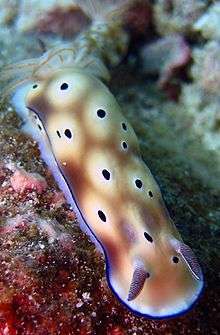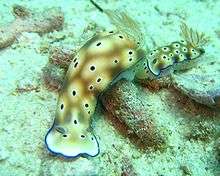Hypselodoris tryoni
Hypselodoris tryoni is a species of sea slug, a dorid nudibranch, a marine gastropod mollusk in the family Chromodorididae.[2]
| Hypselodoris tryoni | |
|---|---|
 | |
| Scientific classification | |
| Kingdom: | Animalia |
| Phylum: | Mollusca |
| Class: | Gastropoda |
| Subclass: | Heterobranchia |
| Order: | Nudibranchia |
| Suborder: | Doridina |
| Superfamily: | Doridoidea |
| Family: | Chromodorididae |
| Genus: | Hypselodoris |
| Species: | H. tryoni |
| Binomial name | |
| Hypselodoris tryoni (Garrett, 1873)[1] | |
| Synonyms[2] | |
| |
Taxonomic history
The decision to include Risbecia species within the genus Hypselodoris was made on the basis of a molecular (DNA) study which showed that Risbecia species are a clade inside the genus Hypselodoris as currently constituted.[3]
Distribution
This species was described from the Society Islands. It is reported to occur widely in the tropical Western Pacific Ocean from Australia to the Philippines.[4][5][6]

Description
Hypselodoris tryoni has a brown body and white foot. The body and upper dorsum are covered in purple spots ringed with white or light-brown. The gills are typically translucent white or light-brown and the rhinophores are brown to dark-brown and covered in circular white lines. It has a thin blue or purple line on the mantle edge.[7] There is some colour variation between individuals. Hypselodoris tryoni is similar in appearance to Goniobranchus geminus, Goniobranchus kuniei and Goniobranchus leopardus, although it lacks the wide purple mantle edge line present in those species. Goniobranchus species also tend to have a lower, more rounded body.[8] Sea slugs such as Hypselodoris tryoni, are known to exhibit trailing behaviour where up to four animals will follow one another very closely, often touching. It is not known what causes this behaviour.[9]
Hypselodoris tryoni reaches at least 60 mm in length and has been observed to raise and lower its head while crawling.[10]

Ecology
Like many slugs in the family Chromodorididae, Risbecia tryoni feeds on sponges and have been seen feeding on sponges from the genus Dysidea. When feeding they are sometimes accompanied by a species of shrimp, Periclimenes imperator, in an apparent form of commensalism.[11]
References
- Garrett, Andrew. 1873. Description of a new species of Goniodoris. Proceedings of the Academy of Natural Science, Philadelphia, p. 232, pl. 4.
- Caballer, M. (2011). Hypselodoris tryoni (Garrett, 1873). Accessed through: World Register of Marine Species on 9 June 2012
- Johnson R.F. & Gosliner T.M. (2012) Traditional taxonomic groupings mask evolutionary history: A molecular phylogeny and new classification of the chromodorid nudibranchs. PLoS ONE 7(4): e33479.
- Rudman, W.B., 1999 (January 22) Risbecia tryoni (Garrett, 1873). [In] Sea Slug Forum. Australian Museum, Sydney.
- Rudman W.B. (1984) The Chromodorididae (Opisthobranchia: Mollusca) of the Indo-West Pacific: a review of the genera. Zoological Journal of the Linnean Society 81 (2/3): 115-273. page(s): 196
- Rudman W.B. (1987) The Chromodorididae (Opisthobranchia: Mollusca) of the Indo-West Pacific: Chromodoris epicuria, C. aureopurpurea, C. annulata, C. coi and Risbecia tryoni colour groups. Zoological Journal of the Linnean Society 90: 305-407 page(s): 379
- Gosliner, T.M., Behrens, D.W. & Valdes, A. (2008) Indo-Pacific Nudibranchs and seaslugs. A field guide to the world's most diverse fauna. Sea Challengers Natural History Books, Washington, 426 pp. page(s): 270
- Debelius, H. & Kuiter, R.H. (2007) Nudibranchs of the world. ConchBooks, Frankfurt, 360 pp. ISBN 978-3-939767-06-0 page(s): 140
- Rudman, W.B., 2003 (March 5) Trailing behaviour. [In] Sea Slug Forum. Australian Museum, Sydney.
- Terrence, Gosliner (2015). Nudibranch & Sea Slug identification : Indo-Pacific. Valdéz, Ángel,, Behrens, David W. Jacksonville, FL. ISBN 9781878348593. OCLC 923635251.
- Swann, R., 2007 (May 16) Feeding Risbecia tryoni from Borneo. [Message in] Sea Slug Forum. Australian Museum, Sydney.
External links
- Photos of Hypselodoris tryoni on Sealife Collection
| Wikimedia Commons has media related to Hypselodoris tryoni. |